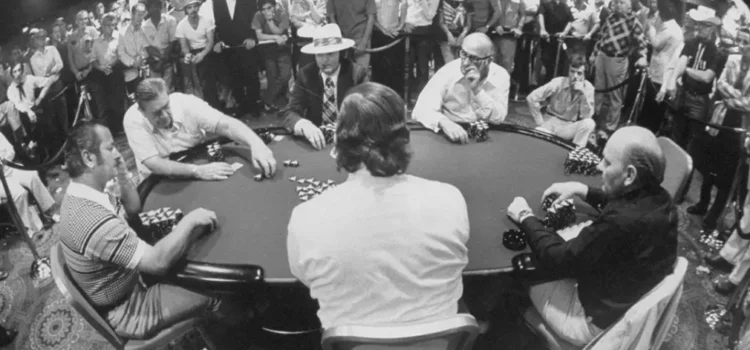
공유하다:
Poker has grown from humble beginnings into one of the world’s most popular card games, captivating players with its intricate blend of skill, strategy, and chance. Its origins trace back to centuries-old European and Persian card games, and it has since evolved into a cultural staple in America and worldwide. This article dives deep into poker’s rich history, its transformation through various eras, and how the game became a centerpiece in online gaming, entertainment, and professional gambling.
1. Historical Roots and European Influences
To fully appreciate poker, it’s essential to understand the games that influenced its development. Historians generally agree that poker’s history begins in Europe, with roots in games dating back to the 16th and 17th centuries. A few of the most influential of these include:
- As Nas (Persia): As Nas was a Persian game played with 25 cards and a limited set of suits, using principles of betting and hand rankings similar to modern poker. This game introduced structured gameplay where players could strategize based on the ranks of their hands and was one of the earliest examples of a card game with dedicated betting rounds.
- Primero (Spain and Italy): Dating back to the Renaissance period, Primero involved elements of bluffing and betting. Players would receive a hand of three cards and place bets based on their rank. This game spread across Europe, inspiring similar games that contributed to poker’s betting structure.
- Poque (France) and Pochen (Germany): French settlers brought the game Poque to the New World, specifically to Louisiana. Poque, similar to Primero, involved betting and bluffing, which later became defining features of poker. Pochen, a German game with a name meaning “to knock” or “to brag,” also introduced the art of bluffing and the competitive style that influenced poker’s development.
These early games set the stage for poker by laying down essential rules that would become central to the game’s identity, such as bluffing, betting, and hand rankings. As settlers traveled from Europe to America, they brought these games with them, shaping the framework of poker.
2. Poker in Early America and the Wild West
Poker as we know it started to take shape in 19th-century America, especially during the period of Western expansion and the Mississippi riverboat gambling boom. Initially, poker was played with a 20-card deck (Aces, Kings, Queens, Jacks, and Tens) and had limited hand rankings compared to today. It spread among riverboat gamblers and was played in saloons along the Mississippi, becoming a popular game for travelers and locals alike.
The game eventually expanded to a 52-card deck, which allowed for more players, hands, and variations. Around this time, poker became closely associated with the Wild West, where saloons hosted high-stakes games and gunslingers faced off across poker tables. The popularity of poker surged during this era, and it became a defining part of the American frontier experience.
By the late 1800s, variations like Stud Poker and Draw Poker emerged, which allowed players to trade or “draw” new cards to improve their hands. This added a new layer of strategy and further established poker as a game requiring both skill and intuition.
3. Influential Poker Variants and Regional Adaptations
As poker spread across the United States, various regions developed unique versions of the game, each with its own rules and gameplay style. The most influential of these were:
- Texas Hold’em: Arguably the most popular poker variant today, Texas Hold’em originated in Texas and gained widespread popularity in the mid-20th century. Unlike Draw Poker, where players could exchange cards, Texas Hold’em allowed players to build hands from a combination of community cards and their own hole cards. This variant was introduced to Las Vegas casinos in the 1960s and quickly became a staple in poker rooms across the country.
- Seven-Card Stud: Before Texas Hold’em’s dominance, Seven-Card Stud was the most commonly played poker variant in the U.S. Players receive a mix of face-up and face-down cards, with betting rounds in between. This version became particularly popular in Eastern states and remained a favorite for many years.
- Omaha: Omaha is similar to Texas Hold’em but allows each player to use four hole cards and five community cards, making it a game of high action and challenging decision-making. It is especially popular in high-stakes games and online poker tournaments.
These variants enriched poker’s gameplay and allowed it to appeal to a broader audience. Each version attracted new players and contributed to poker’s evolution from a simple betting game to a complex sport of skill.
4. The Growth of Poker in Popular Culture
Poker’s rise in the 20th century went hand-in-hand with its depiction in popular media. Countless movies, books, and television shows portrayed poker as a symbol of risk-taking, strategy, and rugged individualism. Movies like The Cincinnati Kid (1965) and Rounders (1998) romanticized the life of professional poker players and drew attention to the game’s skillful nature.
Television played an enormous role in popularizing poker, especially with the introduction of the “hole cam” in the early 2000s. This allowed viewers to see players’ cards and understand the strategies behind each decision. Televised poker tournaments like the World Series of Poker (WSOP) brought the game into living rooms worldwide and helped elevate poker from a pastime to a professional sport. Players like Chris Moneymaker, who won the WSOP Main Event in 2003 as an amateur, inspired millions to try poker, sparking what is often called the “poker boom.”
5. The Rise of Online Poker and Its Global Reach
With the advent of the internet in the late 1990s, poker saw another revolution. Online poker platforms allowed players to compete from the comfort of their own homes, and games were available around the clock. The ease of access brought in players who might not have tried poker otherwise, significantly expanding the game’s reach.
The ability to play poker for real money online was a game-changer. Platforms like PokerStars and Full Tilt Poker grew rapidly in popularity, offering a wide range of stakes, tournaments, and game types. Online poker allowed for quick hands, more hands per hour, and the ability to play multiple tables at once, further enhancing the game’s appeal.
Global poker tournaments like the World Poker Tour (WPT) and European Poker Tour (EPT) attracted international audiences, making poker a truly global phenomenon. Today, millions of people play poker online, either casually or professionally, with major tournaments offering prize pools in the millions.
6. Strategies, Skill, and Bankroll Management
Poker is often described as a game that takes minutes to learn but a lifetime to master. Success in poker requires a blend of strategy, psychological insight, and effective bankroll management. Here are a few foundational concepts for players at all levels:
- Hand Selection: Knowing which hands to play and which to fold is fundamental. Skilled players understand the value of starting hands and make decisions based on position, table dynamics, and opponents’ tendencies.
- Bluffing and Reading Opponents: Bluffing is a vital skill in poker but requires precise timing and observation. Skilled players can “read” their opponents’ body language, betting patterns, and reactions to deduce their possible hands.
- Bankroll Management: Managing one’s bankroll ensures players don’t risk more than they can afford. It involves setting limits, avoiding emotional decisions, and adjusting stakes based on the player’s financial situation and skill level.
Many top players use software tools to analyze hand histories, track win rates, and simulate scenarios, providing them with deeper insights into the game and helping refine their strategies.
7. Poker’s Role in Modern Entertainment and Professional Gaming
Poker has grown far beyond the tables of casinos and saloons; it is now an established part of modern entertainment and esports. High-stakes tournaments, like the WSOP and WPT, offer multi-million dollar prize pools, attracting both amateurs and professionals. Esports arenas have begun hosting poker events, and the integration of technology has only fueled poker’s reach.
With a blend of mathematics, psychology, and risk-taking, poker attracts players from all backgrounds, offering a unique combination of skill and excitement. Online streaming platforms like Twitch have brought poker to a new generation, where top players share strategies, entertain fans, and compete in live-streamed games.
Conclusion: The Lasting Appeal of Poker
From its beginnings as a simple betting game in European cardrooms to its current status as a global phenomenon, poker’s journey is a testament to its adaptability and universal appeal. Whether played at a physical table or through an online platform, poker continues to attract millions with its balance of skill, strategy, and luck. Its rich history, diverse styles, and strategic depth have made it one of the most enduring games in human history, beloved by players worldwide.
The evolution of poker—from the early days of riverboat gambling to televised tournaments and online platforms—has transformed it into a game that transcends age, culture, and geography. For enthusiasts, poker offers a journey that is as much about self-improvement as it is about competition, combining elements of ancient games with modern technology in a dynamic, ever-evolving sport.












